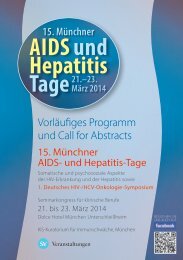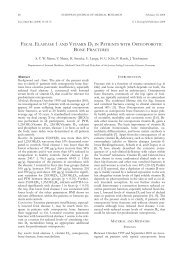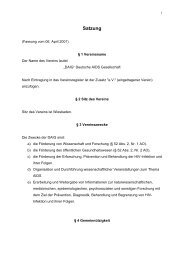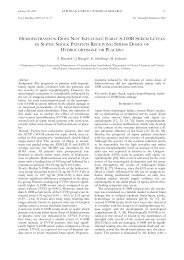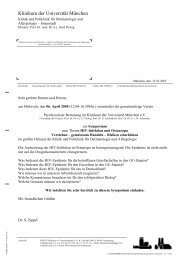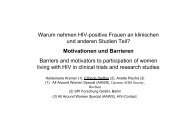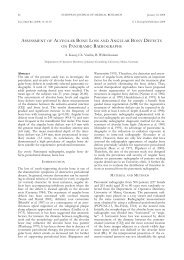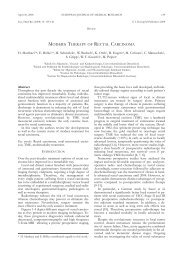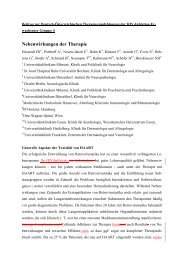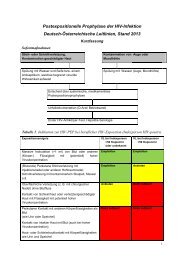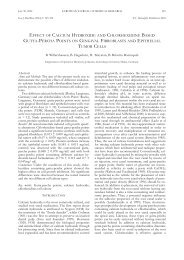European Journal of Medical Research - Deutsche AIDS ...
European Journal of Medical Research - Deutsche AIDS ...
European Journal of Medical Research - Deutsche AIDS ...
Create successful ePaper yourself
Turn your PDF publications into a flip-book with our unique Google optimized e-Paper software.
June 27, 2007 EUROPEAN JOURNAL OF MEDICAL RESEARCH<br />
91<br />
prove this entry inhibitor for further HIV gene therapy approaches<br />
we are developing an antiviral gene product that is<br />
secreted from transduced cells to provide a bystander protective<br />
effect for the prevention <strong>of</strong> HIV infection <strong>of</strong> the transduced<br />
as well as non-transduced cells.<br />
Methods: As the C46 peptide itself is too short for secretion,<br />
we are testing different strategies to achieve secretion:<br />
First, the C46 was elongated by different linker sequences,<br />
further on a “multimer” <strong>of</strong> several C46 units linked by protease<br />
cleavage sites was generated. A third approach is the fusion<br />
<strong>of</strong> C46 to a secretable scaffold protein.<br />
Cell lines were transfected or transduced with vectors encoding<br />
the different secretable C46-derived peptides (sC46).<br />
Cell lysates and cell culture supernatants were analysed in respect<br />
<strong>of</strong> protein expression and secretion rates as well as inhibitory<br />
capacities. In addition, the impact <strong>of</strong> glycosylation <strong>of</strong><br />
the peptides on the secretion rates and inhibitory potential was<br />
analysed.<br />
Results: The transfection and transduction <strong>of</strong> cell lines with<br />
the different sC46-encoding vectors resulted in reasonable expression<br />
and secretion <strong>of</strong> sC46 peptides. Mutation <strong>of</strong> multiple<br />
glycosylation sites lead to a decrease <strong>of</strong> expression and secretion.<br />
In a single round infection assay the supernatants from<br />
transfected cells were able to inhibit the entry <strong>of</strong> viral particles<br />
into two different cell lines, but they were quite ineffective<br />
compared to the closely related fusion inhibitor T-20.<br />
Conclusions: Subsequent work will be directed at further improvement<br />
<strong>of</strong> the inhibitory efficacy <strong>of</strong> the peptides. Afterwards<br />
reduction <strong>of</strong> the immunogenicity <strong>of</strong> the peptides and<br />
further testing <strong>of</strong> their efficacy in T lymphocytes will be analyzed.<br />
D.32 (Poster)<br />
Efficacy data <strong>of</strong> the German open-label study to<br />
assess the safety <strong>of</strong> tipranavir co-administered<br />
with low-dose ritonavir (TPV/r) in patients with<br />
advanced HIV-1 infection and limited treatment<br />
options<br />
Goldbach J. 1 , Moll A. 2 , Esser S. 3 , Theobald T. 4 ,<br />
Mauss S. 5 , van Lunzen J. 6 , Eskoetter H. 1<br />
1 Boehringer Ingelheim Pharma GmbH & Co. KG, Ingelheim,<br />
Germany, 2 HIV specialised practice, Berlin, Germany,<br />
3 University Hospital, Essen, Germany, 4 HIV specialised<br />
practice, Munich, Germany, 5 HIV specialised practice,<br />
Duesseldorf, Germany, 6 University <strong>Medical</strong> Center, Hamburg-<br />
Eppendorf, Germany<br />
Purpose: To assess the safety and efficacy <strong>of</strong> TPV/r under<br />
conditions comparable to those to be expected for TPV/r in a<br />
real world clinical setting.<br />
Methods: Adult patients (pts) had to be triple antiretroviral<br />
(ARV) class experienced having failed at least two previous<br />
PI-based regimens. The study medication was TPV/r 500/200<br />
mg, twice daily added to a optimised background regimen<br />
based on genotypic resistance data chosen by the treating<br />
physician.<br />
Results: Data <strong>of</strong> 254 HIV-1 infected pts (median age 44<br />
years, 229 males, 25 females) from 70 centres were available<br />
for analysis. Most pts were in stage CDC B3 (28%) and C3<br />
(57.1%). Pts were highly pre-treated with a median prior exposure<br />
to 12 ARVs: 5 NRTIs; 1 NNRTI and 4 PIs. 17.7% <strong>of</strong><br />
pts were pre-treated with the fusion inhibitor enfuvirtide<br />
(ENF). Hepatitis B and C co-infection was reported from<br />
medical history for 12.6% and 3.9% <strong>of</strong> the pts respectively. In<br />
an on treatment analysis after 12 months <strong>of</strong> therapy pts<br />
achieved a median VL reduction from baseline (median 4.7<br />
log10 copies/mL) <strong>of</strong> -1.9 log10 copies/mL and the median increase<br />
<strong>of</strong> CD4 cell count from baseline (median 157 cells/mL)<br />
was +71.5 cells/mL. 55.9% <strong>of</strong> pts started ENF with TPV/r at<br />
baseline. After 12 months use <strong>of</strong> ENF in conjunction with<br />
TPV/r compared to TPV/r without ENF provided a greater<br />
median decrease <strong>of</strong> VL (-2.28 vs. -1.43 log10 copies/mL respectively)<br />
and a greater median increase in CD4 cell count<br />
(+87 vs. +59 cells/mL respectively).<br />
Conclusions: Patients participating in the German open label<br />
safety study were in an advanced stadium <strong>of</strong> HIV-1 infection<br />
and highly pre-treated with low CD4 cell count and high viral<br />
load. Treatment with TPV/r, especially in combination with a<br />
new class (ENF) was associated with potent and durable VL<br />
reduction and increase <strong>of</strong> CD4 cell count, demonstrating an<br />
improvement <strong>of</strong> immunological status.<br />
D.33 (Poster)<br />
Switch to a completely ONce daily regimen<br />
containing Emtricitabine/Ten<strong>of</strong>ovir-fixed dose<br />
combination plus Third QD partner: 24 weeks<br />
interim analysis <strong>of</strong> the SONETT trial<br />
Weitner L. 1 , Kuhlmann B. 2 , Fenske S. 3 , Freiwald M. 4 ,<br />
Ebrahimi R. 5 , Mertenskoetter T. 6 , Ranneberg B. 6 ,<br />
Arasteh K. 7<br />
1 Infektionsmedizinisches Centrum Hamburg, Praxis St. Georg,<br />
Hamburg, Germany, 2 Praxis Georgstrasse, Hannover,<br />
Germany, 3 Infektionsmedizinisches Centrum Hamburg,<br />
Grindelpraxis, Hamburg, Germany, 4 Private Practice, Berlin,<br />
Germany, 5 Gilead Sciences, Foster City, United States <strong>of</strong><br />
America, 6 Gilead Sciences, Martinsried, Germany, 7 Epimed,<br />
Berlin, Germany<br />
Background: Study GS-934 found superior responses in terms<br />
<strong>of</strong> virologic suppression, CD4 response and discontinuations<br />
for adverse events in ART-naive pts randomized to<br />
TDF+FTC+EFV in comparison to AZT+3TC+EFV. We evaluated<br />
the impact <strong>of</strong> switching patients with adherence or tolerability<br />
problems from CBV (AZT/3TC) + 3rd partner to a regimen<br />
<strong>of</strong> TVD (TDF/FTC) + divergent qd partner in a 48 wk<br />
prospective open label single arm multicenter Phase III trial.<br />
Methods: 52 patients on a stable CBV-containing HAART<br />
for 12 wks with VL < 50 c/mL and CD4 > 50 cells/mm3 were<br />
switched to TVD + 3rd partner. Assessments including VL<br />
and CD4 were performed at BL and wks 4, 12, and 24 postswitch.<br />
Summary <strong>of</strong><br />
Results: 7/52 patients discontinued early. At BL, median<br />
CD4 was 526 (IQR: 317-774) cells/mm3, median Hb was14.8<br />
(IQR: 14.1-15.3) g/dL. 41/52 patients had taken CBV for >1<br />
yr; 26 switched to TVD for simplification, 20 due to AEs, 6<br />
for both reasons. TVD was mainly combined with EFV<br />
(n=30) or NVP (n=13). Viral Suppression was maintained<br />
with viral load < 50 copies/mL at week 24 in 43/51 (84%) enrolled<br />
patients. In 2 additional patients viral loads <strong>of</strong> 50 and<br />
59 were observed at Week 24; both dropped to



